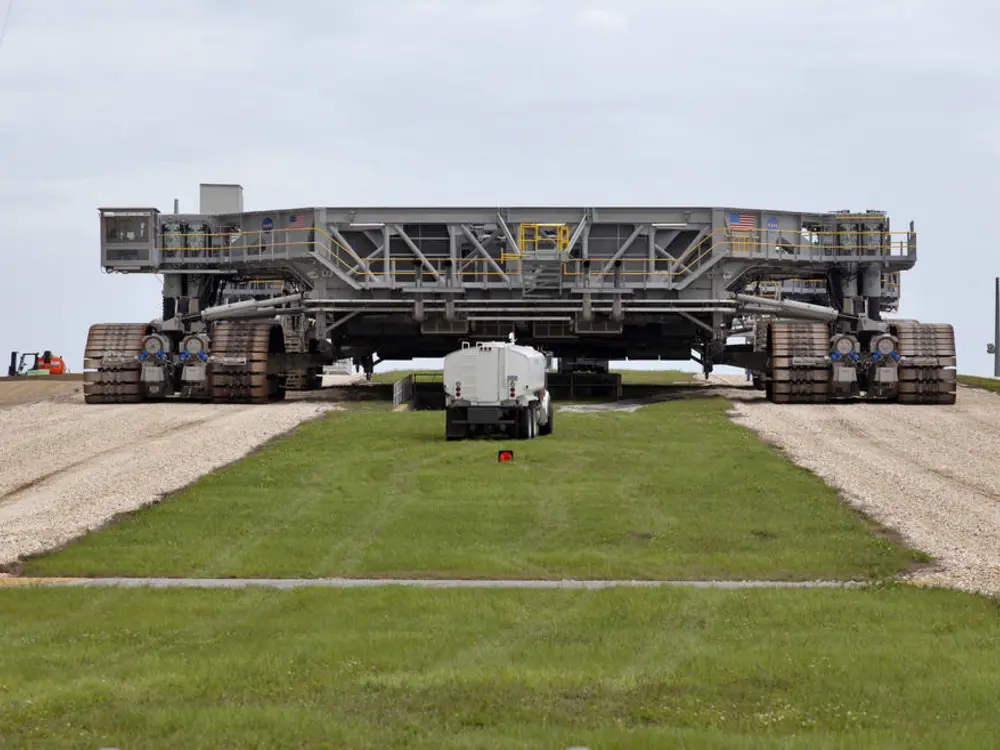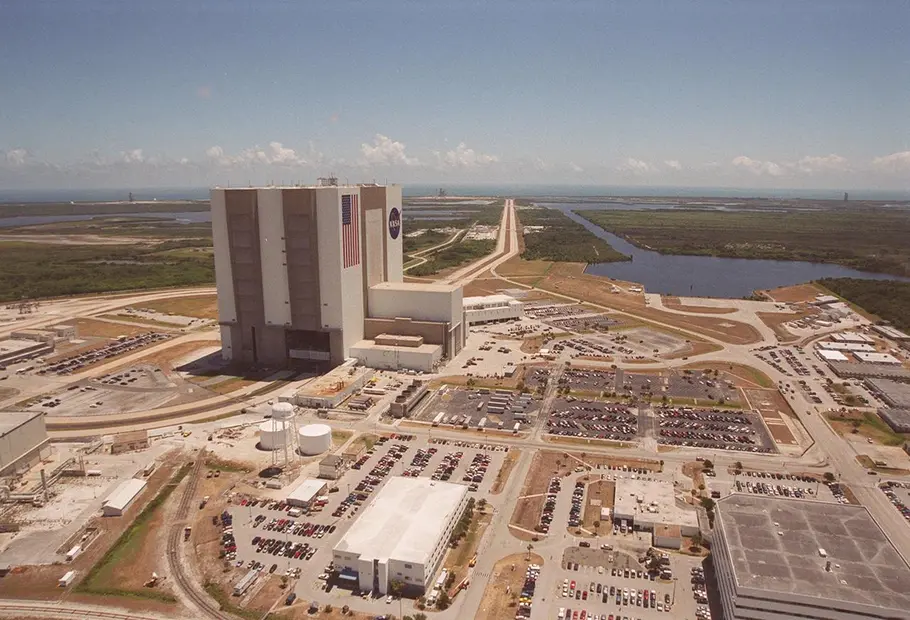
Preserving Launch Infrastructure
Jul 05, 2023
By Colleen E. Anderson
Launching a rocket is a complex operation, requiring personnel, equipment, and infrastructure. Space agencies and companies around the world, therefore, build giant ground systems to support launches. One of the largest and best-known launch complexes is Launch Complex 39 (LC 39), which NASA has used at Florida’s Kennedy Space Center to stack and launch rockets for the Apollo, Skylab, Space Shuttle, and Artemis programs, among others.
A panorama of Launch Complex 39 at Kennedy Space Center in the Space Shuttle era, including the Vehicle Assembly Building in the center, the central Crawlerway road, and launch pads in the distance, next to the Atlantic Ocean.
All these programs have relied on a similar method of assembly. Apollo and Skylab’s Saturn V and Saturn IB, the Space Shuttle’s Space Transportation System, and Artemis’ Space Launch System (SLS) have all had their final construction inside the massive Vehicle Assembly Building (VAB). At 525 feet tall, the VAB is one of the largest buildings by volume in the world. Stacking the launch vehicle inside protects it from weather, including Florida’s frequent storms.
Crawler-Transporter-2 stands outside of the Vehicle Assembly Building at the Kennedy Space Center.
This method of construction has a clear advantage over building directly on the launch pad but also introduces two additional requirements. First, what should the launch vehicles be stacked on? And second, how should this tall and heavy construction be transported the four miles from the VAB to the launch pad? The answers to both questions lie with two massive structures.
One crucial structure is a moveable launch platform, which is a multi-purpose platform used for assembly, transport, and launch. While inside the VAB, the moveable launch platform provides a base for assembly. The launch vehicle, any boosters, and other necessary launch infrastructure are stacked on top of it. Once stacking is complete, the launch platform then acts as the base that supports the entire structure as it moves from the VAB to the launch pad. At the launch pad, the platform then becomes the support structure for the launch itself. The mobile launch platform means that the rocket can launch from the same structure on which it was stacked, eliminating the need for a complex transfer.
Apollo, Skylab, the Shuttle, and Artemis have all used mobile launch platforms, each tailored to the particular needs of the launch vehicle. Three Mobile Launchers (ML) were constructed for the Apollo program. The massive Saturn V rocket and the Launch Umbilical Tower were both stacked on the ML.
Apollo 4 travels to the launch pad atop the Mobile Launcher in 1967.
The Space Shuttle program was able to reuse the three Apollo-era MLs with some modifications. These reconfigured platforms with the towers removed were given new names—Mobile Launch Platforms (MLP). Two towers were fixed instead to pads 39A and 39B. The three MLPs provided the support structure for 30 years of Shuttle launches.
Artemis also uses a mobile launch platform. Given the enormous size of its SLS launch system, it is unable to reuse the Shuttle-era MLPs. Two new Mobile Launchers (ML) will be used for the program. ML-1 was used for the first Artemis launch and will be used for the second and third on SLS Block 1. ML-2 will be used for the upgraded SLS Block 1B and Block 2.
The Artemis Mobile Launcher returns to the VAB after completing tests in 2020.
The mobile launch platform provides the foundation needed to stack and launch the rocket, but it does not solve the problem of transportation from the VAB to the launch pad. This is the job for one of NASA’s two massive Crawler-Transporters (CT). A CT ferries the mobile launch platform along the road known as the Crawlerway that leads to the launch pad.
Both crawlers seen from above, with the Crawler Transporter Maintenance Building between them.
The Crawler-Transporter is truly enormous. In fact, it is one of the biggest self-propelled land vehicles in the world. It is 131 feet long and 114 feet wide, about the size of a baseball infield. It weighs around 6.6 million pounds, which is about the same as 1,000 pickup trucks.
CT-2 crawls up the ramp to Launch Pad 39B for a test in 2018.
The Crawler Transporter moves on eight treads, each of which are made up of 57 individual ‘shoes.’ These are much larger than regular shoes. Each is 7.5 feet long and 1.5 feet wide and weighs over 1 ton. The CT’s size allows it to carefully move the launch platform at a top speed of 1 mile per hour. The Crawler keeps the launcher entirely level throughout the whole journey, even while moving up an incline to the launch pad. This ensures that the launch vehicle remains exactly centered and vertical. Once the mobile launch pad is in place, the CT crawls back down the Crawlerway before launch.
The two crawlers were originally constructed in 1965 by Marion Shovel Company in Ohio and were first used for Apollo 4, an uncrewed test launch. Both CTs remain in active use today, and they are largely unchanged since the 1960s. CT-2 will be used for future Artemis launches. CT-1 will support the many other rockets that launch from Kennedy Space Center.
A Crawler Transporter moves out from underneath the Mobile Launch Platform after bringing Space Shuttle Discovery to the launch pad prior to a 2001 launch.
Both the mobile launch platforms and the CTs are enormous, meaning that they are both much too large to fit inside either of the National Air and Space Museum’s two locations. Even NASA does not have enough space to store the MLPs now that they will not be used for Artemis. At the same time, both structures are integral to the histories of three space programs. How can the Museum collect artifacts to tell this history? One way is through preserving representative components that can speak to the history, use, and scale of these pieces of infrastructure.
From the Crawler Transporter, the Museum’s collection boasts two tread shoes. Seeing the shoes up close gives a sense of scale. Additionally, it is possible to see that these are shoes that have been used. Their wear and tear speaks to the heavy load that the CT carries as it moves the vehicle to the launch pad.
One of two CT shoes in the Museum’s collection.
Recently, the Museum also acquired part of the second Shuttle-era launch platform, MLP-2. When NASA decided to dismantle MLP-2, the Museum had an opportunity to collect and preserve a component from the historic structure that launched four Apollo flights, the Skylab Orbital Workshop, and 44 Space Shuttle missions, including the first flight of every Shuttle apart from Columbia. The Museum decided to collect one of the marked panels from the exterior of the platform. This panel, which itself is about 4 feet tall and 900 pounds, gives a sense of the structure’s enormous scale. Like the tread shoe, its wear and tear speaks to its use across dozens of launches. Furthermore, the panel shows markings from the cutting torch used during dismantling, thereby telling a different side of the story, namely the afterlives of ground-based structures, which often follow a different trajectory than the more iconic rocket boosters that they launched.
The Museum’s work complements what other organizations do to preserve this important history, especially while the infrastructure is still in use. In 2000, for instance, the Crawlerway and Crawlers were entered into the National Park Service’s National Register of Historic Places, the official list of places in the United States deemed historic and worthy of preservation.
Space agencies and increasingly private companies are continuously building up ground-based infrastructure, which means that the National Air and Space Museum will need to continue thinking through how it can collect representative components from these enormous structures in the future.
Related Topics
You may also like

We rely on the generous support of donors, sponsors, members, and other benefactors to share the history and impact of aviation and spaceflight, educate the public, and inspire future generations. With your help, we can continue to preserve and safeguard the world’s most comprehensive collection of artifacts representing the great achievements of flight and space exploration.
Support the Museum
We rely on the generous support of donors, sponsors, members, and other benefactors to share the history and impact of aviation and spaceflight, educate the public, and inspire future generations. With your help, we can continue to preserve and safeguard the world’s most comprehensive collection of artifacts representing the great achievements of flight and space exploration.












